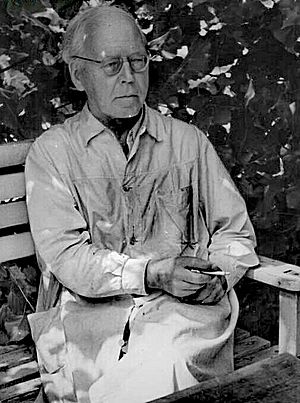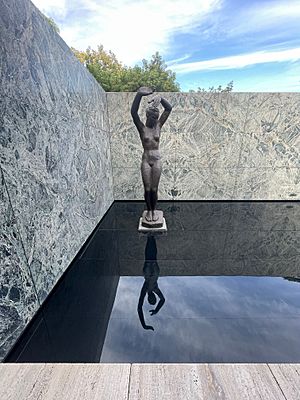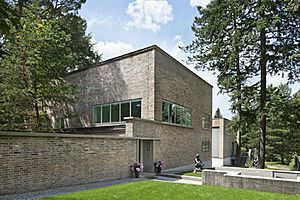Georg Kolbe facts for kids
Georg Kolbe (born April 15, 1877 – died November 20, 1947) was a famous German sculptor. He was one of the most important sculptors of his time in Germany. He created strong, modern sculptures in a simple, classical style. His work was similar to that of the French sculptor Aristide Maillol.
Contents
Early Life and Training
Kolbe was born in Waldheim, Saxony, a town in Germany. He first trained to be a painter in cities like Dresden, Munich, and Paris. But when he was in Rome around 1900, he started learning to sculpt. He got help from another sculptor named Louis Tuaillon.
His Career as a Sculptor
In 1905, Kolbe joined an art group called the 'Berliner Sezession'. Later, in 1913, he joined another group called the 'Freie Sezession'. He became very well-known in 1912 with his amazing sculpture called "Die Tänzerin" (The Dancer). This became his most famous artwork.
Kolbe was interested in different kinds of faces, especially Asian faces. An Indian man named D. N. Mazumdar, whose daughter became a famous writer, posed for him. Kolbe made a sculpture of his head and upper body. In 1929, Kolbe also worked with architects Lilly Reich and Ludwig Mies van der Rohe for a sculpture in the Barcelona Pavilion. Mies van der Rohe placed Kolbe's sculpture Alba (Dawn) in a small pool of water.
Kolbe also made many prints, which are like drawings printed from a plate. He started making these around 1900. For a short time, from 1919 to 1920, he mostly focused on smaller sculptures and drawings. His art was even part of the art competition at the 1928 Summer Olympics in 1928.
Throughout his career, Kolbe received many important requests for sculptures. He even made some for the German government during the time of the Nazi Party in his later years. However, it is said that he refused to sculpt a portrait of Adolf Hitler. From 1937 to 1944, Kolbe regularly showed his work at a big art show in Munich. One of his large sculptures, Verkündigung (Proclamation) from 1924, was a main artwork at the 1937 German Pavilion. In 1939, he created a sculpture of the Spanish leader Francisco Franco. This sculpture was given to Hitler as a birthday gift. In 1944, near the end of World War II, Hitler and Joseph Goebbels listed Kolbe as one of the twelve most important visual artists.
After Kolbe passed away, a monument for the composer Ludwig van Beethoven (which he worked on from 1926 to 1947) and the Ring der Statuen were put up in Frankfurt am Main.
Georg Kolbe died from bladder cancer in Berlin on November 20, 1947.
Public Sculptures
Kolbe's sculptures can be seen in many public places. Here are a few examples:
- 1912 Die Bachnymphe in Bonn
- 1913 Monument for Heinrich Heine in Frankfurt am Main
- 1917/1918 Monument in Tarabya, Istanbul, Turkey
- 1924 Verkündigung in Lübeck
- 1925 Der Morgen (The Morning) and Der Abend (The Evening) in Berlin
- 1926–1947 Beethoven-Denkmal in Frankfurt am Main
- 1928 Fliegender Genius in Ludwigshafen am Rhein
- 1933, 1935 Zehnkämpfer (Decathlete) and Ruhender Athlet (Resting Athlete) at the Olympic Stadium in Berlin
His Legacy and Museum
The building where Kolbe lived and worked from 1929 to 1947 is in Berlin-Westend. It was designed by Kolbe himself with architects Ernst Rentsch and Paul Linder. It has a garden filled with sculptures. Today, this place is the Georg Kolbe Museum. It is a museum that shows sculptures from the 20th century and modern art.
The museum has shown works by many other famous sculptors and artists. Some of these include Aristide Maillol, Henry Moore, August Gaul, and Auguste Rodin.
Awards
- 1905 Villa Romana prize
Images for kids
See also
 In Spanish: Georg Kolbe para niños
In Spanish: Georg Kolbe para niños






